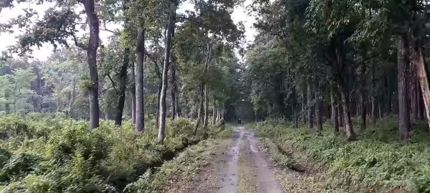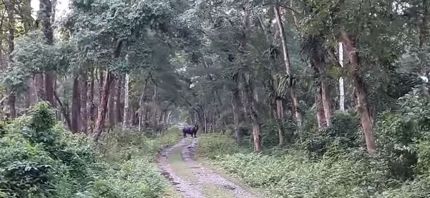Chilapata Forest Safari, Dooars
Chilapata forest is part of Jaldapara National Park... the two have been divided by river Torsha. Jaldapara is to the west of Torsha while Chilapata is to the east, and in between the river flows. In recent times Chilapata has come to prominence as a lot of tourists who visit and stay at Jaldapara, have also started taking car Jeep safaris at Chilapata.
Actually most of the wildlife that you can see in the main forest of Jaldapara can also be seen at Chilapata and that includes one-horned rhinos, elephants, leopards, bisons, many different kinds of deers like chital, sambar, hog deer, barking deer etc, and of course plethora of birds.
We were staying at Madarihat Tourist Lodge of WBTDCL which is located at a short distance from the main entry of Jaldapara National Park on the national highway. However for Chilapata, we would turn to the other direction on National Highway. You can get your permits from Assistant Wildlife Warden's office located close to the Madarihat Tourist Lodge, take a guide and proceed on your own vehicle, otherwise you can also get a safari vehicle, permit and guide at the entry gate of Chilapata.
Having crossed river Torsha along the national highway #317, we passed by Hashimara town and reached Barodabri which is about 15kms from Madarihat. Here we left the highway and veered right towards a route which leads all the way to Coochbehar. At the junction of these two roads you will find a Gurudwara and a Balaji temple. As we turned right at the junction, we found Malangi Tourist Lodge run by WBFDC (of forest department) on the right hand side. Once there used to be elephant rides offered from this tourist lodge (although there was only one elephant for the ride).
We drove another 3kms from Barodabri along this route and reached Kodalbasti Check Post. This is where the entry gate to Chilapata forest is located. Once you complete the entry formalities and pay up the fees, you are all set to get into the jungle.
Chilapata Forest
There are three main safari locations in Chilapata forest... 1) Central Cord Line (better known as CC Line) where there is a watchtower, 2) Ruins of the fort of Nal king that was built in 5th century, 3) Mendabari forest area. And there are of course numerous forest routes through the dense jungles which are ideal for exploring wildlife, birds and flora.
As we entered the jungle and drove along for a while, at one point the driver took a right turn towards the CC Line Watchtower. The view from the watchtower is stunning... you can see a vast stretch of Torsha river and the grassy land of Jaldapara National Park on the other side, and dense jungle on this side at Chilapata. The guide said all through the year many wild animals such as elephants, gaurs, rhinos cross over the river from both sides, but not is monsoon when the river is full of water.
We returned to the main forest route and continued, and took a right turn again after a while towards the ruins of the fort of Nal King. Unlike what we saw at Jaldapara National Park which was full of elephant grass, this part of the jungle has a huge density of teaks and sal trees making archways across the routes. Combined with thickly populated shrubs the forest here is really dense where lights could hardly penetrate.
I observed that the jeep that was far ahead of us and looked like a small dot had stopped and we were getting closer fast. The guide mentioned that they must have spotted something on the way. Our driver drove fast and brought the vehicle just next to theirs and what we say was unbelievable.... a rhino right on the middle of the forest road with its eyes locked on us.
Rhino at Chilapata forest... looking straight at us
Our cars had shut down the engines. But the rhino kept looking straight at us for about 5 minutes, and when it saw no movement at our end, gradually crossed over to the jungle. The guide mentioned, we are lucky that it did not decide to charge at us. Having waited for a while even after the rhino left, we started to move ahead.
But there is nothing much to be seen as far as the fort is concerned. It's all in ruins now and not virtually maintained. Other than some exposed walls of bricks there is hardly anything remaining of the fort. This fort was built by the Nal King in 5th Century during the dynasty of Gupta empire. It's located 2kms from the main forest route and deep inside the jungle. Near the fort you can find trees called 'Ramgua' ... only couple of them are now left. These trees are have a unique blood-like red fluid that come out of their bark when cut.
After some more drive through the jungles in this area we came back to the main forest route and reached the Chilapata Check Post. The distance from Kodalbasti Check Post to Chilapata Check Post is 23kms. This entire stretch is full of dense forest. The guide mentioned that leopards are quite common in this part of the jungle. Sometimes Royal Bengal Tigers can also be spotted but quite rarely.
Chilapata Forest Bungalow is located near the Chilapata Check Post. Further ahead we took a left turn towards Mendabari. This is another area of the jungle which is full of dense forest and wildlife. There are many routes through the forest to explore if you have time. Unfortunately we did not. We went further ahead, crossed the bridge over Kaljani river, reached the National Highway #317 again and headed back to Madarihat Tourist Lodge.
Go through
Jaldapara National Park in case you are looking for information about where to stay around Chilapata, how to reach etc. A day trip to Chilapata from Madarihat (Jaldapara) is a popular option for tourists. There are of course forest bungalows too at Chilapata and also the Menda Jungle Camp.
Related Articles
|
Visitors' Reviews/Comments
|

